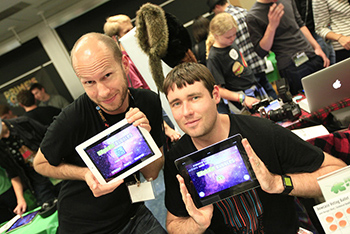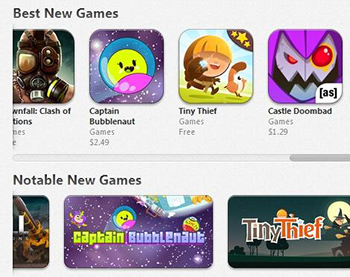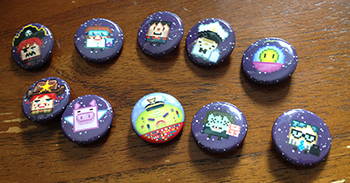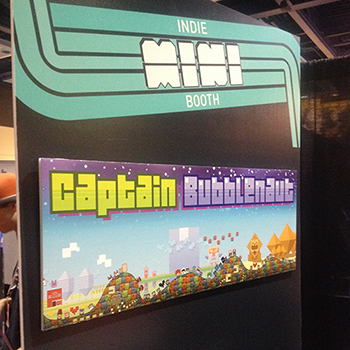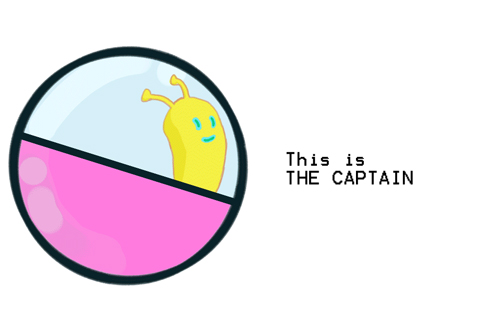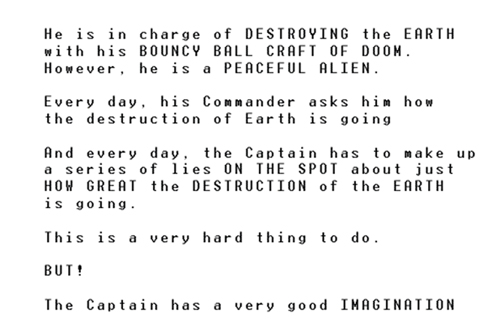What is Captain Bubblenaut?
Captain Bubblenaut is an arcade action game where you swoop, roll and bounce a ball into targets to earn points.
It features a novel control system where you indirectly guide the Captain (ie. the ball) by sliding the terrain around underneath her. Some players describe it as "action Tiny Wings" because of the focus on getting the Captain to land smoothly on the inclines and "swoop" along the dips to smash through targets like bowling pins.
SUMMARY OF RESPONSIBILITIES
Owen Macindoe and I wanted to collaborate on the design for a game and make something truly unique.
I defined a set of design goals and we utilized those in exploring the core design. Together we collaborated on defining and answering new design questions. I designed new systems and tuned them.
I created all art assets and drove our world building efforts.
I marketed the game. I reached out to press and created marketing materials, a website, and the presskit. Owen and I exhibited the game together at events such as Boston FIG and Pax Prime.
ART
THE CAPTAIN AND THE ADMIRAL
I designed the "Captain Bubblenaut" player avatar and her war-mongering galactic warlord father "Admiral Pop".
Captain Bubblenaut is a peaceful alien, but her father wants her to follow in his footsteps and conquer new worlds. So she tells a tale about her conquest of the planet "Erf". The whole thing is in fact a lie.
ERFLINGS
Captain Bubblenaut and her kind are circle-shaped aliens, and so it would make sense that she describes the planet Erf and it's denizens as being disgustingly square-shaped abominations that MUST be obliterated.
Every enemy design began with a blank 32x32 canvas. I pushed to cram as much variety, charm and character into that little square as was humanly possible. I created over 80 enemy variants.
BACKGROUNDS AND THE INVASION OF Planet "ERF"
All of the Erflings are square shaped and so is the planet Erf and its landmarks.
MARKETING
Owen and I showed the game at Boston FIG and PAX Prime 2013. I handled our launch, including the creation of assets for the website, our launch trailer, and handling media outreach. The game was featured on the App Store for our initial release and when we released the universal app update to add iPad support.
Below: That's me on the right.
Read on for more detail on the development process
Read on if you want more detail about how Owen and I made Captain Bubblenaut.
Early Design Process
Captain Bubblenaut was a side-project that I worked on with MIT grad student Owen Macindoe (now a programmer at ArenaNet).
I was interested in exploring mobile game design and strengthening my art skills. Owen wanted to get more general experience building a game from the ground up. Together we wanted to explore unique design ideas.
We started with a thesis:
"Human beings inherently enjoy judging parabolic arcs. From throwing a rock to stun prey, to firing an arrows at invading marauders, to being great at pretty much any sport ever, being good at judging parabolic arcs has always meant having a greater chance of passing on your genes. So, human beings really like judging parabolic arcs, especially in video games."
It was an incredibly highfalutin place to start! But we thought there was something to it. We realized that "judging parabolic arcs" features strongly in video game design.
The great thing about this starting point was that it left us tons of ground to explore the game's core design. The possibilities were wide-open and this was what we wanted: as much room for collaboration as possible.
Early months on the project were spent whiteboarding ideas, playing action games that heavily featured "parabolas" as a theme, and creating extremely simple prototypes.
Building the World and Aesthetic
Even with a small project like this it was very important to me that we build a world for the game to take place in. Even the simplest game can benefit from having the added context that world building provides, and it's a great way of lending structure to the creative process.
The Gif Pitch
We chose a sci-fi theme for the game and were interested in doing our own take on the classic "alien invasion" scenario. To take it in a new direction we asked the question "what if a peaceful alien was tasked with invading the Earth?".
To explore this idea I made a series of storyboards showing how it might manifest in the game. The idea was that as events occurred in the game they would be printed to the screen as text. On the Game-Over screen you would get a "log" of events. This would be your "captain's log", a recording of your quest to destroy the Earth. The twist was that it was all a lie, with the invasion simply being a figment of your imagination and a tall-tale being made up on-the-spot and fed to your expectant commanding officer in order to satisfy his unquenchable thirst for conquest.
This exercise was enough to convince us that the basic premise of "spinning a lie about the invasion of Earth" was strong enough to include in the game. But seeing the textual "captain's log" in the above gif, as well as a very rough prototype to try it in-game, convinced us that the idea did not gel with the fast-paced action of the game (basically: tl;dr).
We made some slight alterations to the core narrative and included it in the shipping game. The Captain became the daughter of the warmongering Admiral, making it a story about the pressures put on a child by their overbearing parent.














